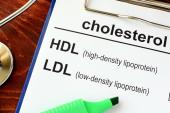Post-ACS Patients With Low LDL Levels Remain at Risk: IMPROVE-IT
Adding ezetimibe to simvastatin lowered the risk of CVD events in those with baseline LDL levels ranging from 50 to 70 mg/dL.

Adding ezetimibe to moderate-intensity statin therapy reduces the risk of major cardiovascular events in post-ACS patients with a range of baseline LDL-cholesterol levels, including those with values considered at target, according to a new analysis of the IMPROVE-IT trial.
For example, even among those with LDL-cholesterol levels ranging from 50 to less than 70 mg/dL, adding ezetimibe to simvastatin lowered LDL further and led to a similar reduction in the risk of cardiovascular death, major coronary events, or stroke as seen in the overall trial, report investigators.
“If a patient has an acute coronary syndrome, but their LDL-cholesterol level is in the 60s, it must mean they’re still at higher risk and there are things we can do,” Robert Giugliano, MD (Brigham and Women’s Hospital, Boston, MA), one of the study’s investigators, told TCTMD. “Of course, you can control blood pressure, get their diabetes under control, and get them to quit smoking, but also the LDL-cholesterol level is still not optimal. That’s what this is telling me. If the LDL cholesterol wasn’t an issue, then they should have done better.”
For that reason, Giugliano believes the new analysis, published today in the Journal of the American College of Cardiology, supports the European Society of Cardiology guidelines that recommend physicians lower LDL-cholesterol levels to a target of less than 55 mg/dL in high-risk patients with atherosclerotic cardiovascular disease (ASCVD). In contrast, the American College of Cardiology/American Heart Association (ACC/AHA) guidelines don’t specifically point to an LDL target, but they do state that additional lipid-lowering therapy is warranted in high-risk patients with LDL-cholesterol levels exceeding 70 mg/dL.
“There is little controversy about lowering LDL-cholesterol levels in patients with an acute coronary syndrome and LDL levels greater than 100 mg/dL,” said Giugliano. “Where the US guidelines don’t support intensifying lipid-lowering therapy is in the group with LDL levels ranging from 50 to less than 70 mg/dL.”
Modest Reductions in ASCVD Events
Published in 2015, the IMPROVE-IT study included 18,144 patients hospitalized with ACS within the preceding 10 days who were randomized to simvastatin 40 mg with or without ezetimibe 10 mg. At 7 years, the addition of ezetimibe translated into a 7% relative reduction in the risk of major cardiovascular outcomes. The purpose of the post hoc analysis, which was led by Kazuma Oyama, MD, PhD (Brigham and Women’s Hospital/Tohoku University Graduate School of Medicine, Sendai), was to assess the reduction in clinical events across a range of patients with different LDL-cholesterol levels at baseline.
At baseline, 2,480 patients had LDL levels ranging from 50 to less than 70 mg/dL (low), 8,097 had LDL levels ranging from 70 to less than 100 mg/dL (intermediate), and 7,422 patients had LDL levels ranging from 100 to 125 mg/dL (high). Median baseline LDL in the three groups was 62, 86, and 113 mg/dL, respectively.
At 4 months follow-up, adding ezetimibe lowered LDL-cholesterol levels an additional 15 mg/dL compared with placebo. This reduction was similar in those with low, intermediate, and high LDL levels at baseline (P = 0.19 for interaction). Similarly, the addition of ezetimibe lowered the risk of cardiovascular death, major coronary events, or stroke by 8%, 7%, and 6% in those with low, intermediate, and high starting LDL-cholesterol levels (P = 0.95 for interaction).
To TCTMD, Giugliano said the characteristics of the post-ACS patient with different starting LDL-cholesterol levels were strikingly different. For example, patients with baseline LDL levels ranging from 50 to less than 70 mg/dL had a higher prevalence of diabetes, hypertension, and heart failure compared with those with intermediate and high baseline levels. Those with low LDL levels also were more likely to have had a prior MI or undergone coronary revascularization prior to the index event. The patients were also higher risk, with 38% of those with low baseline LDL levels having a TIMI risk score ≥ 3 compared with 29% and 17% of those with intermediate- and high-baseline LDL levels, respectively.
“It’s an older, sicker group,” said Giugliano, adding that patients with low baseline LDL levels had the highest event rates in IMPROVE-IT. In the simvastatin monotherapy group with LDL levels less than 70 mg/dL, 42.2% of patients had a clinical event according to the 7-year Kaplan-Meier estimates. In contrast, 37.7% and 29.3% of those with intermediate and high baseline LDL levels had an event on simvastatin monotherapy.
The consistent reduction in major cardiovascular events across baseline LDL-cholesterol levels, particularly in those with low levels, “shows that if you’re below 70 [mg/dL], it’s not good enough if you’ve had an acute coronary syndrome,” said Giugliano. “These data do support a role for further LDL lowering, even when you start below 70. It’s supportive of the ESC recommendation of pushing it below 55.”
Simvastatin 40 mg Not Intense Enough
In an editorial, Vera Bittner, MD (University of Alabama, Birmingham), points out that the current US guidelines recommend high-intensity statin therapy—either atorvastatin 40-80 mg or rosuvastatin 20-40 mg—following ACS and one of the limitations of the IMPROVE-IT analysis, which was launched in 2005, is that patients were treated with simvastatin 40 mg, a moderate-intensity statin.
The new study shows that high-risk patients with low baseline LDL cholesterol will derive benefit with intensified lipid-lowering therapy, but given the design of IMPROVE-IT, “the current analysis cannot answer the question whether the LDL cholesterol threshold for adding ezetimibe or PCSK9 inhibitor should be lowered to ≥ 50 mg/dL among individuals at very high ASCVD risk and using high-intensity statin therapy,” she writes.
For Bittner, the differences in baseline characteristics among the three patient groups reveals why subgroup analyses from randomized trials should always be interpreted with some caution. In terms of the clinical message, the study should remind doctors that post-ACS patients are a heterogenous population and that formal risk stratification should be routinely performed for secondary prevention.
“Baseline LDL cholesterol viewed in isolation is not necessarily a reliable indicator of risk for recurrent events and has to be interpreted in the context of underlying ASCVD risk,” writes Bittner.
Michael O’Riordan is the Managing Editor for TCTMD. He completed his undergraduate degrees at Queen’s University in Kingston, ON, and…
Read Full BioSources
Oyama K, Giugliano RP, Blazing MA, et al. Baseline low-density lipoprotein cholesterol and clinical outcomes of combining ezetimibe with statin therapy in IMPROVE-IT. J Am Coll Cardiol. 2021;Epub ahead of print.
Bittner V. Treatment thresholds and ASCVD risk. J Am Coll Cardiol. 2021;Epub ahead of print.
Disclosures
- Giugliano reports grants Amgen and Anthos Therapeutics; receiving honoraria from Amgen, Centrix, Daiichi-Sankyo, Dr Reddy's Laboratories, Medical Education Resources, Medscape, Menarini, Pfizer, SAJA Pharmaceuticals, Servier, and Voxmedia; and consulting fees from Amarin, Amgen, Bayer, CryoLife, Daiichi-Sankyo, Esperion, Gilead, Hengrui, Inari, Pfizer, PhaseBio Pharmaceuticals, St Lukes, and Sanofi.
- Bittner reports serving on the Executive Steering Committee of the ODYSSEY OUTCOMES trial (Sanofi) and as National Coordinator for STRENGTH (AstraZeneca), DalGene (Dalcor), and CLEAR (Esperion), all contracted through the University of Alabama at Birmingham; she serves as a co-investigator on an academic/industry collaboration between the University of Alabama School of Public Health and Amgen; serves as site principal investigator for the ORION IV Trial (Novartis); and consulting for Pfizer.





Comments